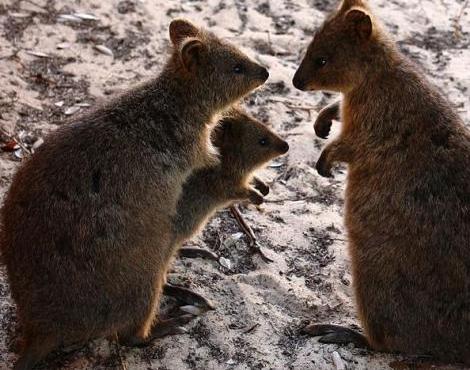Reproduction
The quokka's mating season is usually between January and
February becasue these months are often
cooler in temperature. Also, being nocturnal, these animals look
for and mate during nighttime. During this time, male quokkas
attempt to form a connection with a female quokka in order to
reproduce. They have partner preferences that last for at least
2 breeding seasons. While females only have 1-3 partners, males
have 1-5 partners and continually approach other females to form
new partnerships. Males tend to defend females after they
mate but they never defend them at other times. However, in a
few documented studies, quokkas were found to form long-lasting
pairs and only found new mates after the death of one. This type
of behavior is very uncommon in marsupials like the
koala (McLean et al.,
2008).
and mate during nighttime. During this time, male quokkas
attempt to form a connection with a female quokka in order to
reproduce. They have partner preferences that last for at least
2 breeding seasons. While females only have 1-3 partners, males
have 1-5 partners and continually approach other females to form
new partnerships. Males tend to defend females after they
mate but they never defend them at other times. However, in a
few documented studies, quokkas were found to form long-lasting
pairs and only found new mates after the death of one. This type
of behavior is very uncommon in marsupials like the
koala (McLean et al.,
2008).
However, quokkas are mostly solitary. Females rarely
associate with other females and never initiate interactions with
males. The social structure in males is slightly different because there is
a clear hierarchy in dominance. The heavier the male is, the more
dominant he is. Along with dominance, the size of the male quokka
determines its mating success. (McLean et al., 2008). Mating
success of males also is determined by four factors related to females. One
thing that can affect mating behavior is whether the female’s
reproductive rate can be increased if the male assists in caring for
the offspring. That is, can she have more babies if the father cares
for the young? The second factor is the size of the female’s local
range,
or area that she resides in. The third factor is the size and
stability of the female groups. The fourth and final factor is the
density and distribution of females in a certain space (Hayward
2008).
The mating preferences of quokkas are intricate and vary from population to population. For example, polygamy occurs more frequently in quokka populations where males aren’t necessary to care for the offspring, where females live in small-ranged areas, or when females live in stable, small groupings. On the flip side, monogamy occurs when females live in large ranges and are solitary or when females reside in large, unstable groupings (Hayward 2008). Besides these factors, females also choose who they will mate with (to an extent). If a female is not interested in the male, they will run away. Males will move on to another female if that happens. If a female is interested in the male, she will stay put. She shows interest by grooming or pawing at him. However, if she expresses interest in a subordinate male and then a dominant male approaches, the subordinate male will scamper off. A month after mating, females will give birth to one offspring. This offspring remains in the quokka’s pouch for six months after birth. Quokkas have up to 2 offspring per year (McLean et al., 2008).
For more information on quokkas and their reproduction, check out this website!
Want to know how quokkas interact with other species? Find out how on the Interactions page!
